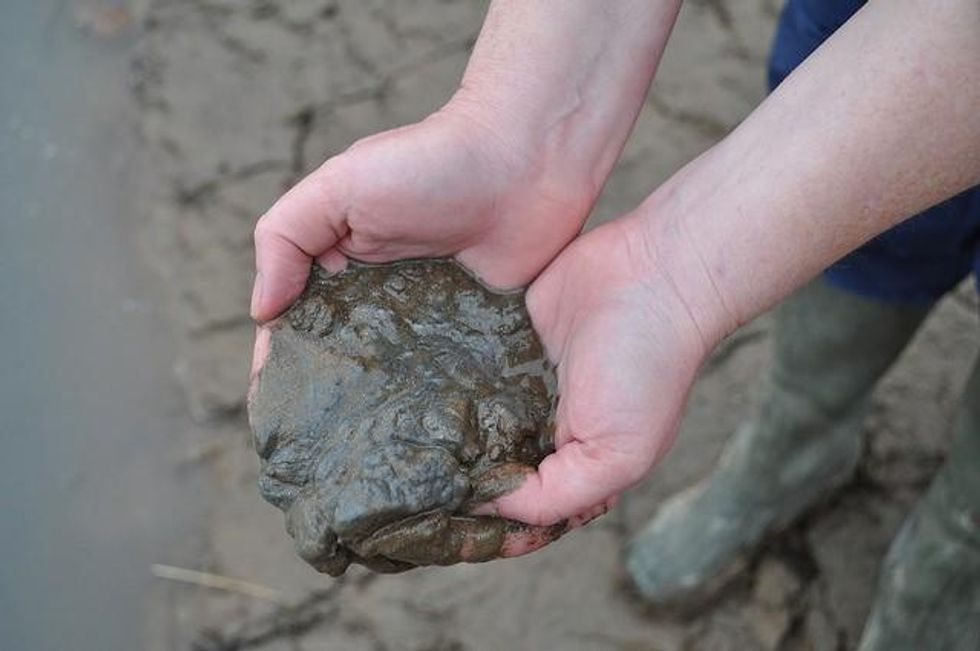As Coal Ash Spews Into N.C. River, More 'Ticking Time Bombs' Threaten
One of largest such spills in U.S. history shines light on 'high-risk' unregulated coal ash dumping grounds near waterways

As a busted pipe at a Duke Energy power plant continues to leak arsenic and lead-laden coal ash into the Dan River that flows through North Carolina and Virginia, residents are demanding that energy giants stop pumping their waterways with poison.
"Any coal ash dump next to a river or lake is a ticking time bomb, and Duke has lost all credibility when it says it's responsible to hold the fuse," Greenpeace Charlotte organizer Monica Embrey said while protesting outside of Duke Energy's headquarters in Charlotte, North Carolina on Thursday along with dozens others. "Duke should clean up its mess in the Dan River and make sure that Charlotte isn't next."
"This could have been avoided. The Environmental Protection Agency has dragged its feet on the issue of coal ash for more than five years," said Matt Wasson, director of programs for Appalachian Voices, in an interview with Common Dreams. "We've been warning about this, commenting to the EPA in public comment periods, and talking to the press."
Duke Energy is still scrambling to repair the leak in a storm pipe at the bottom of a 27-acre coal ash pond. Duke Energy spokesperson Meghan Musgrave told Bloomberg on Tuesday that an estimated 10 percent of the pond's 992,000 tons of ash ( 99,200 tons) have spilled into the Dan River.
Yet Kerul Dyer of Rainforest Action Network told Common Dreams, "There is no way of knowing exactly how much has spilled already because the monitoring by Duke Energy is inadequate."
The coal ash had been stored at the Dan River Steam Station in Rockingham County, North Carolina, which was retired in 2012 and is now a dumping ground for residue left behind by burned coal. While the spill occurred Sunday, the company waited until Monday to publicly announce what appears to be the third largest coal ash spill in U.S. history.
"Here in North Carolina alone, we have 14 coal-fired power plants, each of which has one or more of these unlined, outdated coal ash impoundments," said Wasson. "And every one of these is unlined and built with really shoddy construction standards. We've known that a toxic material like coal ash has to be taken out of these."
The Sierra Club charges that, while big coal ash spills attract media attention, "dangerous contaminants are quietly seeping from coal ash dumps into groundwater supplies across the country or blowing into the air of communities, exposing people and wildlife to toxic substances."
Kara Dodson of Appalachian Voices previously told Common Dreams there is evidence that local residents were already getting sick from leaks and contamination from Duke Energy's ash dumping ground.
Coal ash is known to contain a toxic cocktail of dangerous heavy metals, including arsenic, mercury, lead, and boron. According to the EPA's own estimates, the ash spilled into the Dan River contained over 7,000 pounds of arsenic.
Eye witnesses say the ash has transformed the river into an unnatural gray sludge.
"Two miles downstream, the river is completely opaque, cloudy with this really unnatural ashen gray color, dark and milky," said Wasson. "If you scooped from the sediment from the bottom, all you get is coal ash. It appeared to me that entire bottom of river was covered in 6 to 12 inches of coal ash."
"We are also taking samples 20 miles downstream," he added. "One of our staff people last night said the thickness of ash on bottom is increasing a lot. It's like a lava flow of toxic material moving downstream at slow but steady pace."
According to the Environmental Protection Agency, there are 676 coal ash containment units at 240 facilities in the United States. Forty-five of the units are considered "high hazard," including ten Duke Energy units in North Carolina.
While the EPA floated the idea of regulating coal ash in 2010, it has dragged its feet and to date has released no rules regulating the dangerous residue. This is in part due to pressure from coal and utility companies. In 2009, Duke Energy lobbyist Bill Tyndall personally lobbied the Obama administration against regulating coal ash ponds, according to documents and statements highlighted by Greenpeace.
Environmental groups say the ability of coal companies to dispose of dangerous ash with no regulation highlights the danger, and power, of this industry. "The coal ash waste problem is widespread," said Dyer. It is another high risk factor in the coal industry overall."
Unedited footage of the spill in the Dan River can be seen below:
Eden, NC Coal Ash Spill - UNEDITED FOOTAGEDuke Energy said that 50000 to 82000 tons of coal ash and up to 27 million gallons of water were released from a pond at its ...